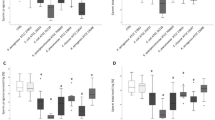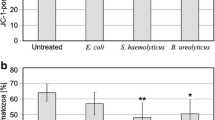Abstract
A hypothesis is presented that microorganisms at very high concentration (>1010/ml) interfere with the sperm-egg interaction by masking the equatorial fibronectin band (EFB) of human sperm and thus impair the fertilization process.
Similar content being viewed by others
References
Akiyama, S. K., Yamada, K. M.: Fibronectin in disease. In: B. Wagner, R. Fleischmajer, N. Kaufmann (eds): Connective Tissue Diseases. Williams & Wilkins, Baltimore 1982, pp. 55–96.
Bedford, J. M., Moore, H. D. M., Franklin, L. E.: Significance of the equatorial segment of the acrosome of the spermatozoa in eutherian mammals.Exp. Cell Res., 119, 119 (1979).
Glander, H. J., Herrmann K., Haustein, U. F.: The equatorial fibronectin band (EFB) on human spermatozoa—a diagnostic help for male fertility?Andrologia, 19, 456 (1987).
Glander, H. J., Schönborn, Ch., Rytter, M.: Microbiological investigations on cryopreserved human semen.Int. J. Androl., 6, 358 (1983).
Grizard, G., Janny, L., Hermabessiere, J., Sirot, J., Boucher, D.: Seminal biochemistry and sperm characteristics in infertile men with bacteria in ejaculate.Arch. Androl., 15, 181 (1985).
Guillet-Rosso, F., Pari, A., Taylor, S., Forman, R., Belaisch-Allart, J., Testart, J., Frydman, R.: Systematic semen culture and its influence in IVF management.Br. J. Obstet. Gynaecol., 94, 543 (1985).
Hewitt, H. J., Cohen, J., Fehilly, C. B.: Seminal bacterial pathogens and in vitro fertilization.J. In Vitro Fert. Embryo Transfer, 2, 105 (1985).
Klebe, R. J.: Isolation of a collagen-dependent cell attachment factor.Nature, 250, 248 (1974).
Kuusela, P.: Fibronectin binds to Staphylococcus aureus.Nature, 276, 718 (1978).
Mc Gowan, M. P., Burger, H. G., Baker, H. W., de Krestern, D. M., Kovacs, G.: The incidence of non specific infection in the semen of infertile and subfertile males.Int. J. Androl., 4, 657 (1981).
Toth, A., Lessel, M. L.: Asymptomatic bacteriospermia in fertile and infertile men.Fertil. Steril., 36, 881 (1981).
WHO-Laboratory Manual for the Examination of Human Semen and Semen Cervical Mucus Interaction. Cambridge University Press, Cambridge-New York-New Rochelle-Melbourne-Sydney 1987.
Author information
Authors and Affiliations
Rights and permissions
About this article
Cite this article
Glander, H.J., Herrmann, K. & Haustein, U.F. Impairment of the fertilization process by adherence of microorganism to the equatorial fibronectin band (EFB) of human sperm. International Urology and Nephrology 22, 483–486 (1990). https://doi.org/10.1007/BF02549782
Received:
Issue Date:
DOI: https://doi.org/10.1007/BF02549782




